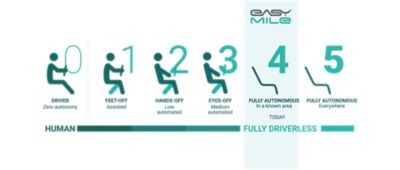-
-
学生向け無料ソフトウェアにアクセス
Ansysは次世代の技術者を支援します
学生は、世界クラスのシミュレーションソフトウェアに無料でアクセスできます。
-
今すぐAnsysに接続!
未来をデザインする
Ansysに接続して、シミュレーションが次のブレークスルーにどのように貢献できるかを確認してください。
国および地域
無料トライアル
製品およびサービス
リソースとトレーニング
当社について
Back
製品およびサービス
ANSYS BLOG
January 5, 2022
Ansys Paves the Way for Safety in Electric Autonomous Vehicle Technology
Today, fully electric driverless shuttles are rolling through college and business campuses and winding through city streets to shape the future of public and private transportation. All-electric, driverless tractors are also enabling autonomous material handling in manufacturing environments to transport materials seamlessly, without interruption, speeding time to market. With the advent of these AI-powered vehicle systems comes a host of safety concerns, which is why Ansys medini analyze was chosen by all-electric autonomous technology supplier EasyMile to define and demonstrate the safety of their electric driverless solutions before they ever see pavement. Ansys and CADFEM France worked together to provide the software and support EasyMile needed to achieve their goals.

EasyMile delivers complete solutions for driverless mobility and goods transportation, partnering with blue chip original equipment manufacturers (OEMs) to autonomize their electric vehicles. The company started out in passenger transport with the EZ10 shuttle, which remains a key solution for them, and they’ve applied this technology to an autonomous TractEasy tractor. The tractor is designed for efficient material handling in manufacturing environments, optimizing logistics operation through cost reduction and an increase in productivity. Operating at Level 4 (L4), EasyMile has completely removed any human supervisor onboard both the EZ10 and the TractEasy during vehicle operation.
The company’s early success is evident in the number of recent EasyMile vehicle deployments at Level 4 around the world. They’re at 10 and counting, which EasyMile says is the largest L4 vehicle deployment on the market to date. A unique in-house software package with an embedded system helps automate both the EZ10 and TractEasy transportation platforms. The software coordinates with numerous vehicle sensors to collect data on the surroundings, which is shared with EasyMile to provide localization, perception, and path planning, resulting in more automated, less infrastructure-centric environments.

Driving Comprehensive Vehicle Safety Analysis
Autonomous vehicle operation depends on a high level of information to operate safely. Both the EZ10 and the TractEasy are equipped with a full range of lidars, radars, sensors, cameras, and GPS hardware, along with navigational software that collect and process data to get 360-degree views of the environment. All use real-time vehicle data processing that will inform autonomous function and intelligence via a software-embedded system. The system is designed to automate transportation platforms. For people transport, the goal is passenger safety, as well as the safety of drivers and pedestrians in the surrounding environment. For goods and material transport, there are predetermined standards for safety already in place that must be tweaked for the safe operation and control of an unmanned vehicle. For both applications, the challenge for EasyMile is working with new systems involving a high level of complexity, without clearly defined methods for how to demonstrate the safety of their autonomous vehicle applications. And this is where medini analyze came into the picture.
“We were developing a very complex autonomous system and needed to demonstrate its safety,” says Romain Dupont, Safety Manager at EasyMile. “This required our team to take a different approach using new solutions to manage requirements, to manage simulation, and to manage a lot of activities that compose the development lifecycle. Among these, medini was key to helping us reach our goals.”

Autonomous vehicle deployments involve education sessions with emergency responders. They also require EasyMile to work with clients globally to help educate government officials at the federal, state, and local levels so vehicles are deployed with all regulatory approvals. medini analyze provided EasyMile with a turnkey system with all the necessary tools at their disposal in one solution. The software enabled EasyMile to manage and define safety analysis of their autonomous products using their own process within medini analyze, thanks to the flexibility of medini to adapt to this process. At the vehicle level, EasyMile used the software to conduct all the safety analysis required from their customers and provide the documentation needed for European safety regulators such as the Safety Services Organization (SSO). It was also used at the subsystem level to analyze connected infrastructure, including interactions among the operator, the deployment team, and all other stakeholders in the transportation system. Recently, with the help of the Ansys team, EasyMile successfully added another tool to medini (a custom extension of the software) to help them drive all safety concepts and requirements into one model for both of their passenger and material transport applications. The tool supported their product line engineering approach and can generate the documentation of all their products for every platform.
“I would say it's almost like we're co-constructing two things here,” says Benieke Terverton, Head of Communications at EasyMile. “We've got our internal approach, as well as what we offer to our clients and our partners about the safety of our products. Ansys and medini analyze have allowed us to co-construct those two approaches to offer something new to the world of autonomous vehicles. We deal with a lot of different assessors and regulators around the world. With Ansys we can manage these interactions successfully.”
Discover how medini analyze can dramatically decrease the effort of functional safety analysis and accelerate time to market.